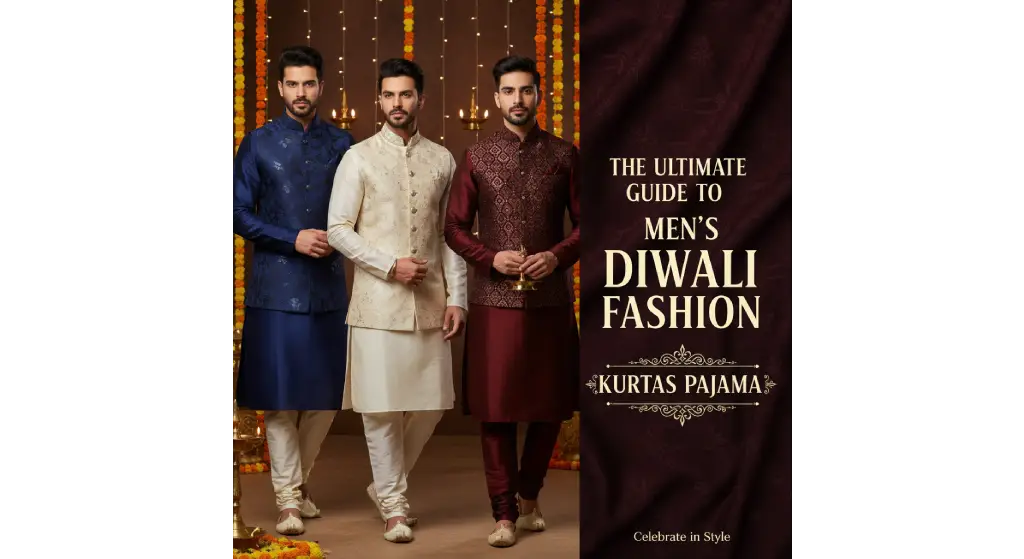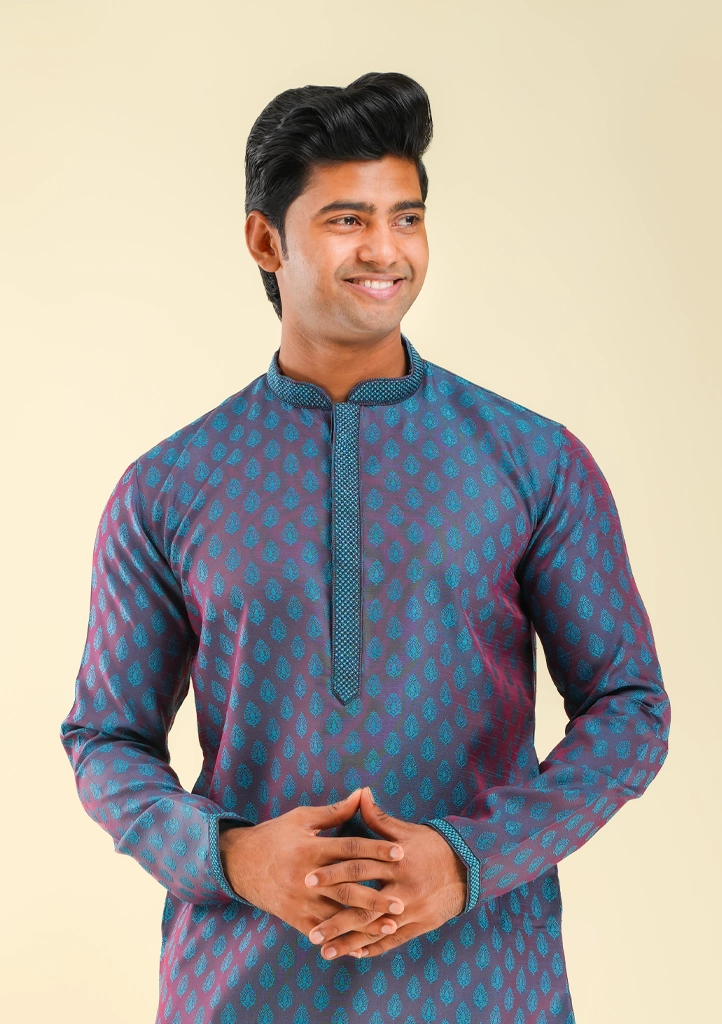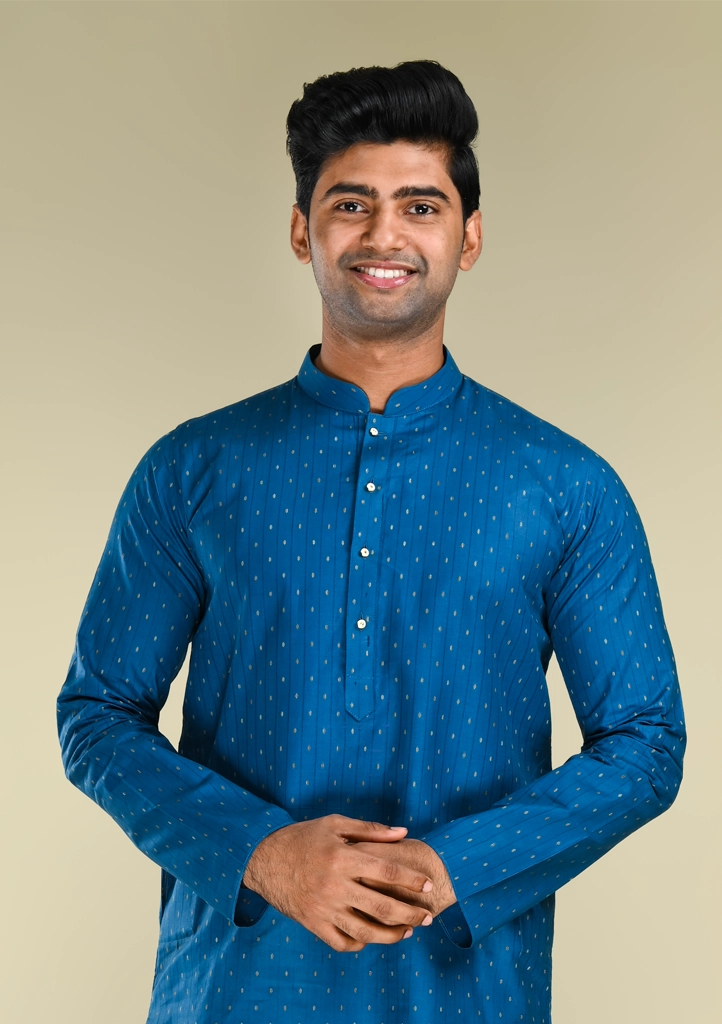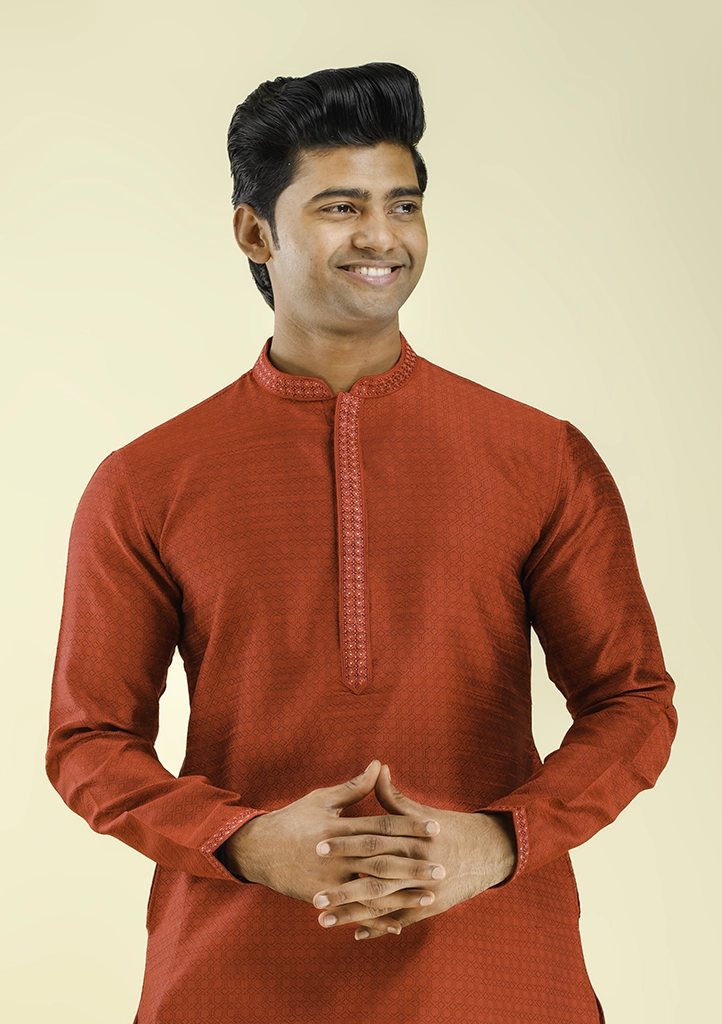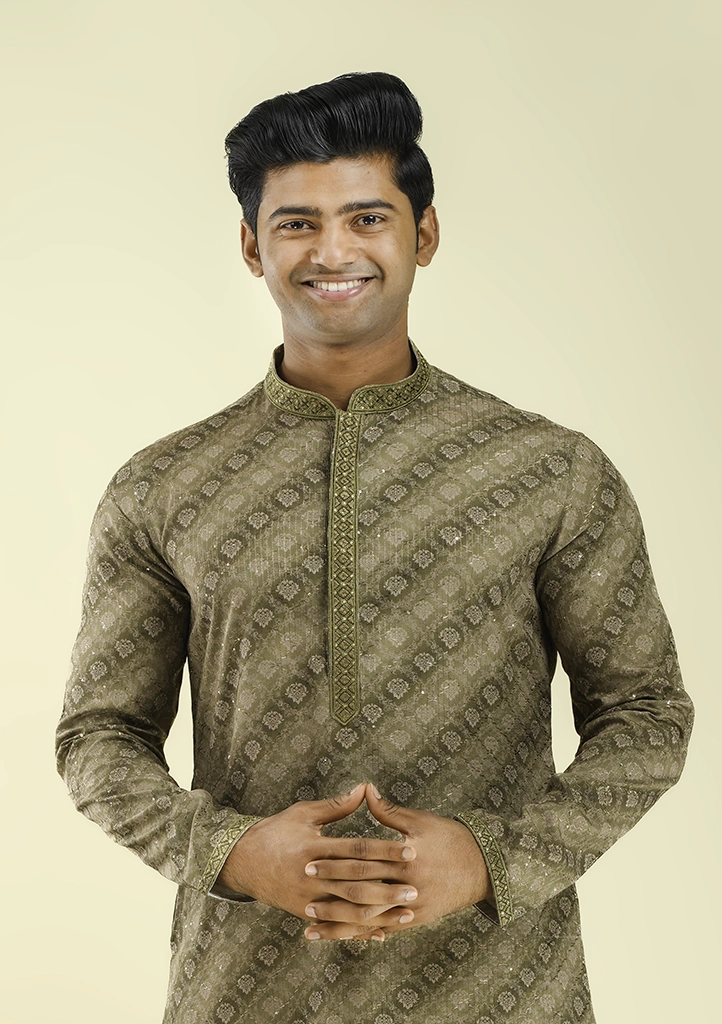Table of Contents
Diwali is not only a festival of lights but also a moment when clothing speaks volumes about heritage, aesthetics and personal identity. In recent years, Indian men have increasingly embraced the kurta pajama as the outfit of choice for Diwali. This traditional ensemble perfectly balances comfort and elegance and provides a canvas for rich textiles and intricate designs.
At Nawab Parker we view Diwali fashion as an opportunity to showcase India’s sartorial heritage while catering to contemporary sensibilities. Throughout this guide we weave together cultural context, practical advice and subtle style nuances to help you select the perfect kurta pajama for the festivities.
How Diwali Kurtas Reflect India’s Rich Fashion Heritage
A history of stitched garments and cultural exchange
The kurta’s lineage stretches back centuries and is intertwined with India’s textile story. Historical sources note that the arrival of stitched garments in South Asia came via Persian “varbana” tunics, which featured side slits, an element that remains in today’s kurta pajama.
During the Gupta period these tunics evolved into local garments, and royal courts under the Mughals elevated the kurta pajama combination to formal attire. Today, variations such as the Bhopali kurta reflect regional tailoring and creative adaptation across India.
Fabrics that store stories within themselves
India’s textiles are globally celebrated; ancient Greek and Babylonian merchants even equated “India” with high‑quality cotton. Cotton remains a staple for kurta pajamas because it is soft, breathable and ideal for warm climates. Handspun khadi and lightweight mulmul (muslin) evoke
Gandhian heritage, while Chanderi fabrics combine cotton and silk to offer a sheer, lustrous feel. Festive kurtas incorporate luxury textiles such as silk, banarasi brocade and velvet to create opulence. This diversity of material allows kurtas to transition across seasons and occasions: in summer cotton, linen, khadi and Chanderi ensure comfort; in winter heavier fabrics like wool, velvet and brocade provide warmth.
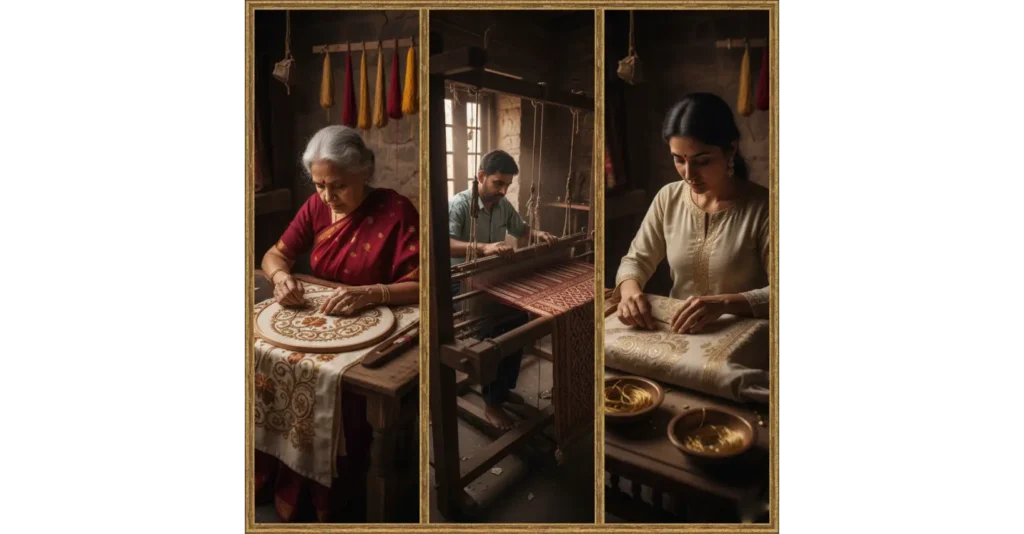

Symbolism and cultural significance
Wearing new clothing during Diwali is steeped in symbolism. Traditional clothing is believed to honour deities and express gratitude for prosperity. The act of donning a fresh kurta signifies new beginnings and discarding negativity, aligning with Diwali’s celebration of light overcoming darkness.
For diaspora communities, dressing in Indian clothes during Diwali reconnects them to their culture and family; participants in a university Diwali performance noted that wearing intricate kurtas made them feel closer to their heritage. Thus, the kurta pajama is more than fabric: it is a bridge between modern life and centuries‑old tradition.
Why Kurta Pajama Are Getting More Popular Every Year as Diwali Outfit for Men
One of the biggest drivers behind the kurta pajama for diwali is rising popularity is comfort. The loose‑fitting silhouette allows freedom of movement and remains breathable even after hours of festive rituals. Articles on kurta styling emphasise that fabrics like cotton, silk or linen ensure that kurtas are comfortable for long celebrations.
Because kurtas come in various cuts, straight, asymmetric or with rounded hemlines, they flatter different body types and can be paired with trousers, dhotis or churidars. Contemporary designers have introduced fusion pieces with asymmetric cuts and innovative details, broadening the appeal beyond traditional settings.
Expression of identity and cultural pride
Modern Indian men appreciate how kurta pajamas allow them to express identity. Selecting a kurta with subtle hand embroidery, bold prints or minimalistic design becomes an extension of personal style.
Wearing traditional attire also signals cultural pride: as Parinita’s fashion blog noted, choosing a kurta pajama allows men to express their heritage through embroidery, fabric and colour choices. In a society where western clothing dominates everyday life, dressing in a kurta for Diwali is a deliberate assertion of Indian identity that resonates with both elders and younger generations.
Timeless elegance and sustainability
The kurta’s design transcends trends. Its clean lines and modest silhouette remain stylish across decades, which means investing in a well‑constructed kurta is sustainable. Fashion writers highlight the kurta pajama’s timeless elegance, noting that it blends tradition with modern style. Many artisans use handwoven textiles and durable stitching techniques that reduce environmental impact. When paired with minimal accessories, a kurta can be worn year after year without appearing dated.
What Makes a Kurta Ideal for Diwali?
Crafted by Nawab Parker — refined fabrics, elegant hues, effortless drape.
Choosing the right fabric is essential. Cotton kurtas are lightweight and breathable, making them ideal for warm Diwali days. Silk kurtas exude luxury and are suitable for formal evening events; however, heavy silk can feel warm in tropical climates, so consider silk blends that incorporate cotton or rayon.
Linen kurtas offer a crisp, relaxed look but wrinkle easily. For cooler climates or evening functions, fabrics like brocade, jacquard and velvet provide warmth and elegance. Always check the fabric’s weight and feel to ensure it suits the weather and your comfort level.
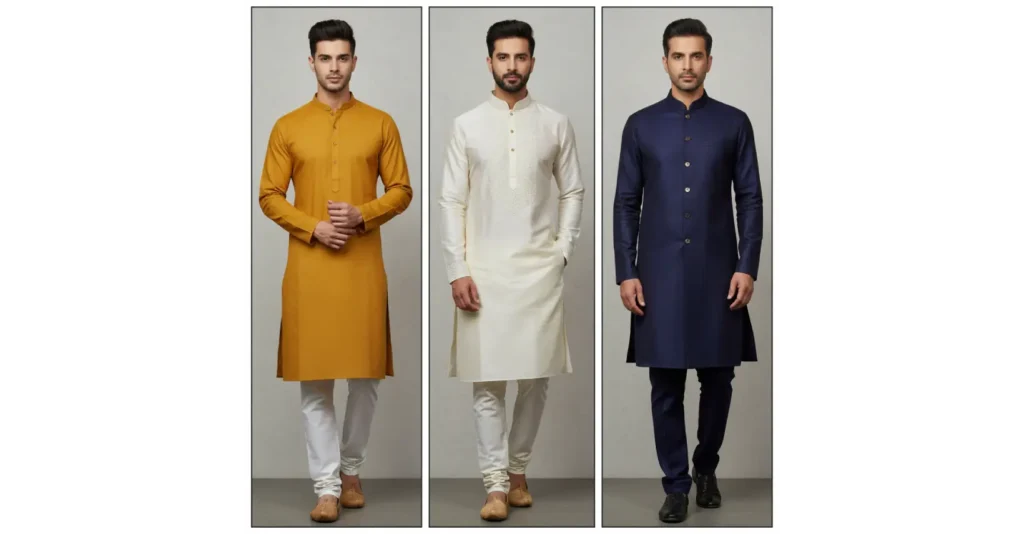

Design details: collars, cuffs and lengths
Modern kurtas feature a variety of collars: the classic band collar (also called mandarin) conveys refinement, while high‑neck or button‑up styles add contemporary flair. Cuffs can be simple or adorned with embroidery; choose understated cuffs for a sophisticated look or embellished cuffs for celebratory occasions. As for length, mid‑thigh kurtas suit slender bodies, whereas knee‑length designs flatter most physiques. Asymmetric hemlines or high‑low cuts, popular in fusion kurtas, create visual interest without compromising tradition.
Colours that capture Diwali’s vibrance
Diwali celebrates light and colour, so vibrant hues are appropriate. Fashion guides recommend bright shades like red, orange, yellow and gold to reflect the festival’s spirit. Pastel tones, mint green, powder blue or peach, create a refined, understated look. When selecting colours, consider skin tone: warm undertones pair well with earthy hues such as mustard or maroon, while cooler undertones look striking in blues and greys. Don’t shy away from experimenting; mixing strong and soft hues can yield a distinctive Diwali ensemble.
Embellishments and embroidery
Artisan embroidery elevates a kurta from simple to spectacular. Fine hand embroidery like zardozi, chikankari and resham thread work adds texture and personality. Sequins and mirror work capture light, making the garment sparkle. However, balance is key: heavy embroidery may overwhelm smaller frames. Minimalistic motifs or geometric prints offer elegance without excess.
Accessories: finishing touches
Accessories transform a kurta set into a complete look. A stole or dupatta draped over one shoulder adds sophistication and can keep you warm on cool evenings. Footwear matters: choose traditional leather juttis, Peshawari sandals or Kolhapuri chappals, these complement the kurta’s silhouette and provide comfort. Statement watches and understated lapel pins provide modern flair; avoid over‑accessorising to maintain balance. During monsoons, pick moisture‑wicking fabrics and pair kurtas with durable footwear to ensure you’re prepared for damp weather. if you follow these steps you will have a proper set of diwali special kurta pajama.
Which Diwali Kurta Matches Your Personality?, Take Our Quiz
Choosing a diwali kurta set that aligns with your personality makes dressing for Diwali more fun. Draw inspiration from the following questions and match your responses to our curated kurta archetypes.
1. What’s your ideal weekend?
- A. Curled up with a book or exploring an art exhibition.
- B. Meeting friends for coffee or brunch.
- C. Attending cultural events and recitals.
- D. Dancing through the night at a lively party.
- E. Trekking or engaging in outdoor sports.
Result:
If you chose A, your introspective nature pairs beautifully with a simple cotton kurta. It offers comfort and understated elegance.
A socialite (B) suits a short kurta paired with dhoti pants for effortless chic.
Cultural enthusiasts (C) gravitate towards a classic kurta pajama set that respects tradition.
Party‑goers (D) need a festive silk kurta with subtle embroidery.
Adventurers (E) should consider durable designer kurtas made from breathable fabrics that allow easy movement.
2. Which colours attract you?
- A. Earthy browns and maroons
- B. Greens and blues
- C. Metallic gold or silver
- D. Pastels and muted tones
Result: Earth tones signal a grounded personality, pair them with rustic fabrics like khadi or raw silk. Greens and blues indicate a calm, creative soul; experiment with Ajrak or block‑printed cotton kurtas. Metallics speak to boldness, choose a kurta with zari work or metallic thread embroidery. Pastels reflect a sophisticated, reflective side; a Chanderi or muslin kurta suits you.
3. What fabric feels most “you”?
- A. Breathable cotton
- B. Soft linen
- C. Luxurious silk
- D. Lightweight georgette
- E. Rich velvet or brocade
Result: Cotton lovers appreciate simplicity and comfort, opt for straight‑cut kurtas. Linen wearers value natural textures and pair them with relaxed pajamas. Silk enthusiasts cherish tradition; go for embroidered kurtas with subtle sheen. Georgette fans enjoy playful movement and may prefer asymmetrical hemlines. Velvet and brocade denote regal taste, choose long, structured kurtas with ornate details. Use this quiz as a starting point to explore your Diwali style.
How to Find the Perfect Kurta for Diwali, No Matter Your Budget
Appreciate affordability without sacrificing style
Contrary to popular belief, you don’t need an extravagant budget to look distinguished during Diwali. Fashion guides emphasise that kurta sets are available at various price points and that stylish options exist even for budget‑conscious shoppers.
The first step is to set a budget: decide how much you’re willing to spend and filter your choices accordingly. This helps prevent impulsive purchases and ensures you prioritise quality over quantity.
Shopping online through curated websites, including our own Nawab Parker portal, can yield discounts during festive sales. Keep an eye out for the end‑of‑season or Diwali specials, as these offer premium garments at reduced prices.
Evaluate fabric quality and design
Budget doesn’t mean you should compromise on fabric. Look for long‑lasting and comfortable materials such as cotton, rayon or silk blends. Opt for minimalistic designs, simple prints and subtle embroidery are elegant yet affordable.
Mix and match by purchasing separate kurtas and pajamas that coordinate with other items in your wardrobe. This approach maximises value and enables you to create multiple outfits from a few pieces.
Trend‑conscious yet wallet‑friendly options
Printed cotton kurtas offer a versatile canvas for everyday and festive wear. Anarkali‑style kurtas with flared silhouettes exude grace and are available in lightweight fabrics like georgette or rayon to keep costs down.
Palazzo kurta sets provide a modern twist with comfortable wide‑leg bottoms, while Chikankari‑embroidered kurtas bring heritage charm without steep price tags. Indo‑Western kurtas with asymmetrical cuts or contemporary prints deliver style at accessible prices.
When styling, focus on accessories; well‑chosen jewellery, quality footwear and neat hairstyles can make a reasonably priced kurta look luxurious. Remember: confidence is the ultimate accessory.
How to Choose the Right Diwali Kurta for Your Body Type
No two bodies are identical, and the right kurta should complement your shape while ensuring comfort. To find the best kurta pajama for diwali you can follow these guidelines: tailored to common body types.
For tall/slim men (ectomorph)
Opt for straight‑cut or semi‑fitted kurtas that add structure without clinging to your frame. Layering with a Nehru jacket can add bulk, and choosing thicker fabrics provides visual volume. Aim for mid‑thigh length to break vertical lines and avoid shapeless, oversized kurtas that may emphasise slenderness. Accessorise with stoles or embroidered cuffs to create visual interest.
For muscular/athletic men (mesomorph)
Your naturally defined physique benefits from slightly tapered kurtas made from lightweight materials like cotton or linen. Choose knee‑length designs that allow ease of movement. Minimal embroidery keeps the look sleek, and opting for soft hues or subtle prints prevents the ensemble from overwhelming your frame.
For heavier men (endomorph)
A straight‑cut or slightly tapered kurta creates a streamlined silhouette. Look for vertical stripes or plain patterns that elongate the body and choose light, breathable fabrics for comfort. Darker colours have a slimming effect, while heavy embroidery or bright colours may draw attention to areas you’d prefer to minimise. Ensure adequate room around the waist and opt for drawstring pajamas or salwars to adjust the fit.
Fabric and length considerations
Cotton, silk blends and linen are versatile fabrics that suit most body types. Georgette or chiffon offers flow for leaner frames but may cling on heavier builds. Choose sleeve lengths that flatter: full sleeves lend a traditional feel, while rolled or three‑quarter sleeves add contemporary flair. For formal events, knee‑length kurtas paired with churidars look regal. Casual gatherings may call for shorter kurtas paired with jeans or trousers.
What to Do When Your Diwali Kurta Doesn’t Fit: Simple Fixes You Need
Even with careful planning, you may encounter fit issues. Rather than abandoning your favourite kurta, consider these practical adjustments drawn from expert tailoring advice.
1. Bust is too tight or too loose
Due to variations in sizing and fabrics with little stretch, the bust area can feel restrictive or baggy. A tailor can add side gussets or matching fabric panels to provide extra room; conversely, if the bust is too loose, darts can create shape without altering the kurta’s design.
2. Gaping necklines
An ill‑fitting neckline may occur when the shoulder‑to‑bust ratio is off or the neckline is cut too wide. Fix this by adding a hidden snap button or small hook to secure the neckline. Alternatively, a tailor can slightly take in the shoulder seam without disturbing any embroidery. These discreet adjustments maintain comfort and ensure modesty.
3. Sleeves that restrict movement
Tight sleeves often result from shallow armholes or narrow widths. Ask a tailor to release extra seam allowance in the armhole. For heavier fabrics, inserting a small underarm gusset improves mobility.
4. Waist fit issues
Standard sizes may not match your natural waistline. Adding side elastic or an adjustable drawstring provides comfort and flexibility. For heavier outfits like sherwanis, a waistband with hooks and a dori (drawcord) offers secure fastening without discomfort.
5. Awkward length
Length problems occur due to differing heel heights or measurement errors. Before altering, wear the footwear you intend to use as a guide and then adjust the hem. For kurtas that are too short, adding a matching border or lace elongates the garment and makes the modification look intentional. Ideally, the hem should skim the knee or mid‑calf depending on personal preference.
Final thought on fit adjustments
A well‑fitted kurta enhances confidence and allows you to enjoy Diwali without discomfort. Investing time in fittings or minor alterations ensures your outfit looks custom‑made.
Five Diwali Style Mistakes to Avoid When Choosing Your Kurta
Even with the best intentions, certain missteps can derail your Diwali ensemble. Here are common pitfalls and ways to avoid them.
- Ill‑fitting bottoms: Wearing loose or baggy pajamas can undermine the kurta’s elegance. Pair straight kurtas with cigarette pants or churidars and avoid baggy lowers that add unnecessary volume.
- Ignoring the occasion: Wearing heavy, embroidered kurtas to casual gatherings or donning basic cotton kurtas to grand celebrations leads to mismatch. Choose subtle prints for informal events and reserve ornate fabrics and embroidery for formal Diwali functions.
- Over‑ or under‑accessorising: Over‑accessorising (piling on jewellery, scarves and flashy footwear) can overwhelm your look, while ignoring accessories results in a plain outfit. Aim for balance; select one statement piece such as a brooch or pocket square and complement it with classic footwear.
- Mismatching colours and prints: Colours and patterns should harmonise with your skin tone and the event’s mood. Avoid clashing prints or colours that are too bright for your complexion. Instead, choose vertical stripes or smaller motifs to create a flattering illusion.
- Ignoring fabric and season: Wearing heavy fabrics like brocade or velvet in summer will be uncomfortable, just as choosing thin cotton for chilly evenings may leave you cold. Select breathable fabrics in warm weather and switch to warmer textiles when temperatures drop. Keep your kurta in good condition by avoiding worn‑out or faded pieces; timely repair or replacement ensures you always look polished.
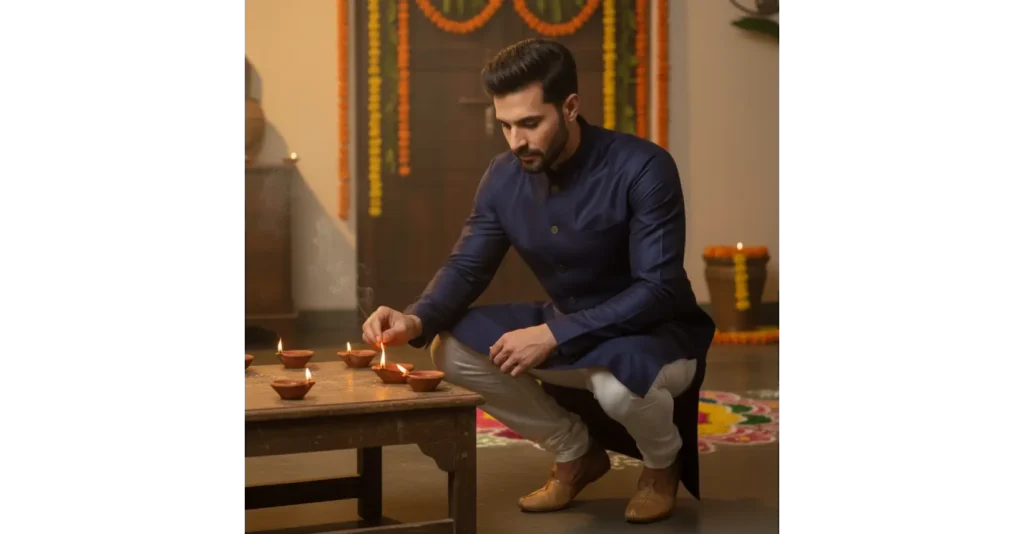

🪔 Final Diwali Readiness Checklist by Nawab Parker
Each celebration begins with preparation. Let this serve as your final check before you step into Diwali, dressed and composed like a true Nawab.
- ☑ Finalize Your Outfit — Choose your Diwali kurta pajama from Nawab Parker’s festive edit. Let the fabric, hue, and silhouette reflect your personal rhythm of celebration.
- ☑ Ensure Tailored Fit — A well-fitted kurta defines elegance. Don’t let last-minute rush alter your perfect neckline or shoulder line.
- ☑ Curate Accessories — Coordinate your mojaris, watch, or stole early. Subtle pairings make the difference between dressed and distinguished.
- ☑ Keep a Backup Ensemble — Have one lighter kurta pajama set ready for relaxed evening gatherings or temple visits.
- ☑ Press & Prepare — Steam or press your attire a day before. Hang it in a breathable cover to maintain its pristine look.
- ☑ Groom with Intent — Trim, style, and refresh. Pair your look with a clean fragrance — preferably woody or amber tones that complement Indian weaves.
- ☑ Set the Mood Around You — Light diyas, arrange warm-toned décor, and choose ambient music that harmonizes with the evening. Style extends to your environment.
- ☑ Confidence Check — The truest reflection of luxury is calm assurance. Wear your outfit, not the other way around.
💬 Final Note from Nawab Parker:
This checklist is not a routine — it’s a ritual. Every detail, from stitch to scent, builds the aura of a Diwali well-spent.
When you’re ready, we’ll make sure your look is too.
FAQs
How many days before Diwali should I buy my kurta?
Purchase your kurta at least two weeks before Diwali. This allows time for alterations if needed and reduces stress from last‑minute shopping.
Is it acceptable to wear a short kurta with jeans for Diwali?
Yes. Diwali fashion has evolved to include Indo‑Western pairings. A short kurta paired with dark jeans and loafers offers a modern look while retaining cultural elements. Ensure the kurta is well‑fitted and complement it with subtle accessories.
Which footwear suits a kurta pajama best?
Traditional options like leather juttis, mojari shoes and Kolhapuri chappals complement kurtas. For a fusion look, suede loafers or brogues can work. Avoid sneakers or athletic shoes as they clash with the elegance of the kurta.
What’s the difference between a churidar and a pajama?
A churidar is a tight‑fitting bottom that gathers around the ankles, creating multiple folds. A pajama (also spelled pajama) is looser and has a straight or slightly tapered cut. Churidars look formal and pair well with longer kurtas, while pajamas offer comfort and are ideal for casual or semi‑formal settings.
Can I wear the same kurta for multiple Diwalis?
Absolutely. The kurta’s timeless design means a high‑quality piece can be worn for years. Refresh it by pairing with different pajamas, jackets or accessories. Proper care, gentle washing, air drying and storing in a cool, dry place, preserves longevity.
Conclusion
Diwali is a celebration of renewal and unity, and dressing thoughtfully enhances the joy of the festival. By understanding the kurta’s heritage, selecting fabrics and designs that honour tradition yet match your style, and making mindful choices according to your budget and body type, you can create a Diwali look that resonates with your personality. Remember that the finest ensemble is one that makes you feel confident. At Nawab Parker we remain committed to preserving India’s sartorial heritage while offering modern silhouettes for the discerning gentleman. We hope this guide empowers you to embrace Diwali kurta pajama fashion with knowledge, pride and flair.
Written by Nawab Parker
Nawab Parker is a menswear label based in Patna, designing structured ethnic wear for Indian men. Our Pathani, Sherwani, and Kurta Pajama for men are crafted for real-world use across weddings, festivals, and formal settings.


